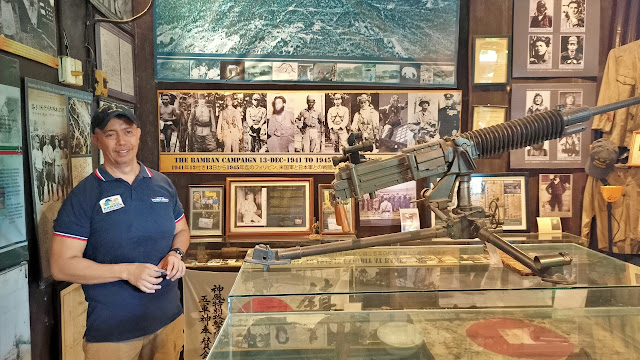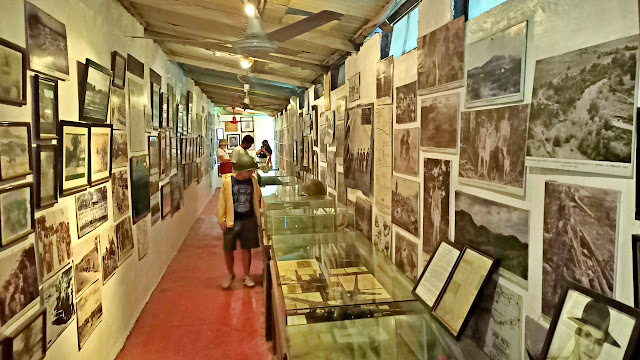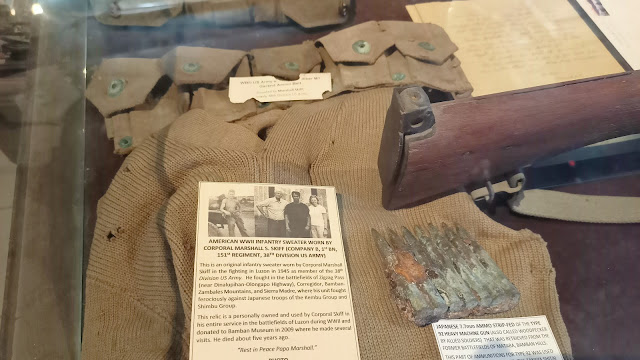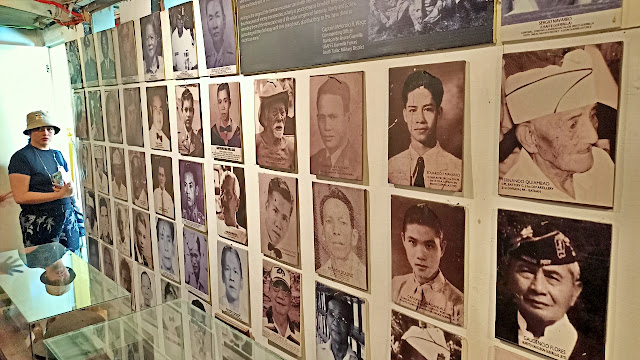The history of World War II was like this wild story that just seeped into the very consciousness of my childhood. Ever since I stumbled upon my late father’s encyclopedia set back in first grade, I've been captivated by the pages that delve into the timeline bridging World War I and World War II.
 |
| Bamban WWII Museum |
Naturally, my fascination focused more on the theatre of war that unfolded within our nation's borders, as Japan's invasion took hold. No tales of valor from our brave Filipino soldiers can be told without mentioning the fierce conflict that raged upon the lands of Luzon, commencing in the tunnels of Corregidor, and descending in madness to Bataan, and subsequent skirmishes all over Luzon's terrain, when guerilla fighters emerged and continued the war following the fall of Corregidor and Bataan.
 |
| Rhonie Dela Cruz of the Bamban Historical Society |
The gallant stand made by Filipino and American soldiers in the Philippines widely delayed the timetable of the Japanese during World War II. After a string of easy conquests in Southeast Asia, the Japanese expected the same to happen in the Philippines that they already looked beyond invading Australia.
 |
| The museum's walls are stacked with WWII photographs and other mementos |
Alas for them, their invasion of the Philippines dragged on for months and General Douglas McArthur managed to escape Corregidor via a submarine heading to Australia to establish the Allied defense.
 |
| A whole day is not enough just by reading the informative captions on each photo |
As a result, the Philippines became one of the most important battlegrounds of World War II, leaving behind a wealth of artifacts, personal letters, and anecdotes.
 |
| This Samurai and Japanese flag was given by a descendant of a Japanese war veteran |
While many of these can be seen in museums across the country, in the municipality of Bamban in the province of Tarlac, one can find a single story establishment that houses a collection of World War II artifacts that rivals or even surpasses that of the country's other dedicated War Museums.
A One-Man Curation of WWII Mementos
As part of the World War II Historical Tour organized by the Department of Tourism — Region III, we visited the Bamban World War II museum when we reached the Tarlac leg of our three-day educational trip that also covered sites in the provinces of Pampanga and Bataan.
Rhonie C. Dela Cruz, who is also the chairman of the Bamban Historical Society, established this museum in 2005. Applying his passion as a historical tour guide accompanying guests many of whom were relatives of American and Japanese war veterans, Rhonnie was able obtain a wide variety of artifacts and relics from his guests.
 |
| Just one of the many personal belongings of soldiers who fought in Bamban-Clark given to Mr. Dela Cruz by relatives |
In a short amount of time, Rhonie's humble abode transformed into a small museum filled with artifacts that evoke the peak WWII events of the years 1941–1945. Inside, visitors can discover a treasure trove of photographs, personal letters, and cherished belongings generously entrusted by family members of fallen war veterans. These artifacts come together to create a vivid and compelling narrative of World War II. There’s also a collection of mesmerizing reels of wartime reportage vividly portraying the fierceness of the Battle of Bataan and those that were fought in the Bamban-Clark area. The Bamban WWII Museum is further enriched by a collection of carefully curated books, maps, articles, and papers sourced from the US National Archives.
 |
| A touching letter of apology written by a Japanese war veteran stationed in the tunnels of Bamban |
When asked what other reason provoked Rhonie to curate such a stunning collection. He told us it was because of his desire to honor the memories of his grandfather, grand uncles and uncles who went to fight during the war, particularly in the pivotal battle of Bamban Hills, where Filipino and American troops delayed Japanese troops' advance to Bataan.
Furthermore, Rhonie Dela Cruz and his fellow members of the Bamban Historical Society are also scouting and surveying a couple of World War II tunnels (including one which he described as "intact Japanese underground Naval headquarters") they soon intend to open to tourists once all surveying methods are completed.
 |
| Photographs of Filipino Guerrilla Fighters in Bamban-Clark |
In what was meant to be a mere pit stop, our visit to Bamban World War II Museum stretched into a couple of hours, as we were immediately gripped by the stories spun by Mr. Rhonie Dela Cruz. Even I, with my vast knowledge of our nation's war history, cannot resist the allure of Rhonie's narratives, as they weave their way into my curious ears.
As we leave the museum's grounds, I reflect on how important it is for younger people to learn not only about the atrocities of war but also about the bravery of the Filipinos who served in World War II as part of the "greatest generation." What better way to achieve that than paying a visit to Bamban World War II Museum and hearing Mr. Rhonie Dela Cruz speak about the war.
I really hope that the National Historical Commission of the Philippines (NHCP) can assist Mr. Rhonie Dela Cruz in preserving his collection by building a museum that meet global standards equipped with a climate- and humidity-controlled features to ensures the longevity of the museum’s collection.
 |
| The WWII Historical Tour Group poses with Mr. Dela Cruz |
Almost 80 years after the surrender of the Japanese and the end of World War II, we continue to wage battle, this time against misinformation. In the fight against falsehoods and historical revisionism, knowledge is a powerful tool in its own right. We should use all the tools at our disposal, including the Bamban World War II Museum.
Klook.com
























